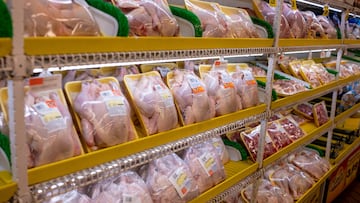The ten supermarket staples that have seen prices rise dramatically since 2020
Feeling the pinch at the supermarket? You are not alone. Prices have risen steadily since 2020, and these are the items that have seen the largest price increases since 2020


The Bureau of Labor Statistics will release the April Consumer Price Index report on Wednesday.
While inflation has softened over the last year, prices are not falling at the rate necessary to provide real relief to most households. Though the rate at which rising prices have slowed, they are still increasing, placing further strain on many workers as wages stagnate.
For many, supermarket receipts are a source of anxiety, with prices on many staples increasing. Those that have seen the largest increase over the last four years are eggs (+55 percent), Margarine (+53 percent), juice and other non-carbonated beverages (+49 percent), peanut butter, sugar, and flour.
Percent increases on key food staples (2020- 2024)
- Eggs: +55.01%
- Margarine: +53.72%
- Frozen noncarbonated juices and drinks: +49.10%
- Peanut Butter/Other oils: +46.31%
- Bread and Crackers: +42.55%
- Sugar: +37.61%
- Flour: +36.37%
- Baby Food: +35.96%
- Canned Vegitables: +35.33%
- Soda: +33.96%
- Beef: +32.12%
- Poultry: +31.90%
Aside from food products, other sectors have also seen shocking price increases over the last four years. For example, auto repairs cost drivers nearly 50 percent more than in 2020. The April Consumer Price Index will be critical to better understanding if inflation is ticking up once again. In February and March, a 0.4 percent increase was recorded, which would put 2024 on track to exceed far the one or two percent increase in price that the US Federal Reserve aims for each year.
Why have prices risen so substantially?
Related stories
In the first quarter of 2024, real wages were unchanged from their position during the same period in 2020. It is not that wages have not increased over the last four years. They have. However, the boost in purchasing power typically associated with these increases has been erased by higher prices. Some economists, including many employed by the US Federal Reserve, point to rapid wage increases in 2020 and 2021 as drivers of inflation. Other experts have different theories, including market collusion, corporate greed, and fragile supply chains that left consumers to front the bill when times got tough.
Price hikes aren’t new, but today’s companies have reinvented them, relying on surveillance, deception, and even high-tech forms of collusion to wring as much as possible out of American consumers.
— Groundwork Collaborative (@Groundwork) May 10, 2024
Read more in our report: https://t.co/9OZUk9gIc5
A report published by Groundwork Collaborative earlier this year found that in the second and third quarters of 2023, corporate greed accounted for more than half —53 percent— of all price increases. In 2019, corporations in the United States brought in $8.31 trillion in profits. Last year, that figure had ballooned 43 percent to $11.89 trillion. Other issues, including supply chain breakdowns caused by the COVID-19 pandemic and the energy crisis sparked after Russia’s invasion of Ukraine, also fueled inflation. However, the findings from the Groundwork Collective show that these economic shocks were used to excuse price gouging that hurt many families who struggled to keep sufficient food on the table.
Complete your personal details to comment